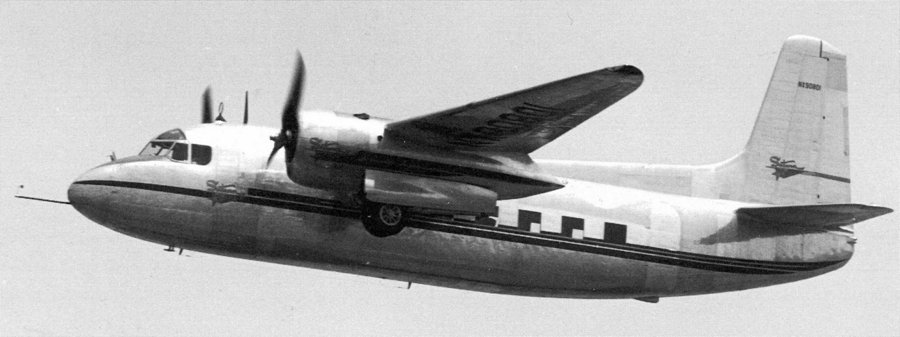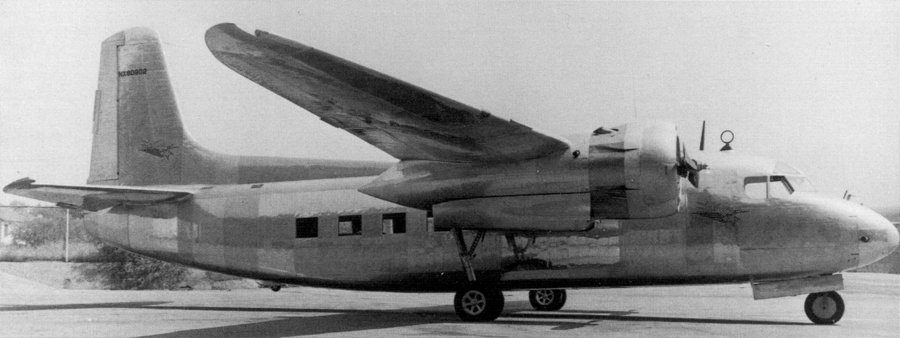The Lockheed Saturn
Competitor - The Lockheed Saturn
Towards the end of the Second World War, there were a number of types being developed in the United States, which threatened to become strong opposition to the Miles Marathon. Most serious of these was the Lockheed Model 75 'Saturn', a small 14-seat feederliner which very closely mirrored key aspects of the Miles project.
With the Second World War drawing to an obvious conclusion, in 1944 the President of Lockheed, Robert Gross, initiated his own style of 'Brabazon Committee' to gain an understanding of airline requirements in the post-war period. He sent teams of market analysts and sales engineers, under the guidance of Carl Squier and Leonard Schwartz out into the field to query not only the airlines, but also the people who would likely be using the airlines, such as bankers, farmers and other business travellers. The resulting data indicated a strong market for a smaller aircraft to feed regional traffic into the major airports, where passengers would connect with longer-range flights aboard full-size airliners.
Lockheed decided to press ahead with the design of an aircraft to meet the 'feeder' requirements of the airlines and the resultant Lockheed Model 75 was entrusted to a design team led by Don Palmer and based in what would soon be known as the 'Skunk Works' in Burbank, California. Palmer's team soon settled on a high-wing, twin-engine monoplane with a tricycle landing gear and minimal ground clearance, to enable direct loading of freight from flatbed trucks. This also meant that passengers could board easily via in-built steps. A novel feature, aimed at reducing spares backup, was that the main landing gear, engine nacelles, horizontal and vertical tail surfaces were interchangeable left-to-right, as well as the wing flaps. Initially designed to use a pair of 600 hp Continental GR9-A 9-cylinder radial engines, the Lockheed aircraft (with a similar weight to the Marathon) would have had approximately 100 hp less in this configuration. The Model 75 was named 'Saturn' and would seat its passengers in two rows of seven seats. Initial estimates for the aircraft showed a 14,000 lb all-up weight and 9,634 lb empty. Fuel capacity would be 492 US gallons, for a range with 45 minutes fuel reserve and 2,740 lb payload of 500 miles. These figures ended up changing by the time that the first aircraft flew. Construction of a mock-up was begun on 12th June 1944.

This is the prototype Saturn in its early guise, with slim Continental engines.
In a clever move, Lockheed chose to publicise the design at the November 1944 International Conference on Civil Aviation in Chicago and with most of the world's airlines gathered in one place, used the Conference as an opportunity to market the new aircraft. Based on post-war expectations, the company was able to declare an initial interest in 500 aircraft, priced at $85,000 each.
Meanwhile, wartime military projects meant a slow production process, though two prototypes were laid down by mid 1945 and Tony LeVier finally took the first aircraft aloft on 17th June 1946. During the ensuing flight test program, LeVier found that the Saturn was underpowered, had poor stall characteristics, and the engines were inadequately cooled. The engine problems proved difficult to overcome and so two 700 hp Wright 744C-7BA-1s were fitted to the first prototype and standardised on all subsequent aircraft. Re-engined, the first prototype returned to the air on 8th August 1947. It subsequently showed improved performance, but was only deemed 'adequate' in most areas.
However, in late 1946 Lockheed had announced that it had decided to temporarily shelve development of the Saturn, citing the lack of a reliable engine at the desired power rating. Later, in February 1947 the company had announced a renewal of the Saturn project because of the availability of the Wright Cyclone engines which were concurrently being fitted to the first prototype. But though the machine did conduct further flight tests, a further u-turn brought the project to a final end later in 1947, Lockheed declaring that the market (despite the earlier announcement of 500 possible orders) was not strong enough. By that time the unit cost had risen to $100,000.

Fitted with more bulbous engine cowlings housing Wright Cyclone engines, this is likely the second Saturn prototype. In general size and shape, the Marathon and Saturn had a great deal in common; both were high-wing, piston-powered feederliners, aimed at a post-war market that wasn't yet ready for them.
In the UK, the Saturn was seen as the main competitor for the Marathon, though George Miles in 1947 was ebullient over the prospects of his aircraft in comparison to the American types. Among his notes was the following entry,
"The main reason I think we might attract interest in the US is that we hold a large Government contract for the Marathon, a four-engined metal feeder line 18 seater, which is the first aircraft of comparable size in the world to meet all the new ICAO requirements in Transport Category “A”. It is evident from the American press that there is an urgent demand for such an aircraft and the Lockheed Saturn, Douglas Skybus, Northrop Pioneer, Beech Quad and other American projects in this category have either been dropped or are in serious difficulties of one kind or another. The Marathon has completed all its official tests with flying colours and it would be false modesty to say that we believe it to be anything less than a world-beater, especially if we could fit American engines in the 300/400 horsepower class. Preliminary enquiries have convinced me that there are important markets for North and South America."
With cancellation of the Saturn, Miles had hoped to pick up some American orders for the Marathon, but with US airlines able to buy war-surplus C-54 (DC-4) airliners at just $25,000 each, it was a tall order.
1946 Comparison: Lockheed Saturn - Miles Marathon
| | Lockheed Saturn | Miles Marathon |
| | | | | | |
| Length | 51 ft 7 in | 52 ft 1 in |
| Span | 74 ft 0 in | 65 ft |
| Height | 19 ft 10 in | 13 ft 9 in |
| Empty Weight | 11,782 lb | 10,260 lb |
| Max Takeoff Weight | 16,000 lb | 16,240 lb |
| Maximum Speed | 252 mph at 10,600 ft | 230 mph |
| Ceiling | 27,700 ft | 24,000 ft |
| Range | 1,940 miles with 45 min reserve | 1000 miles |
| Engines | 2x600 hp Continental GR9-A 9-cyl radial (later 2x700 hp Wright Cyclone 744C-7BA-1 7-cyl radials) | 4x330 hp de Havilland Gipsy Queen 6-cylinder supercharged in-line |
Home

